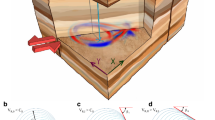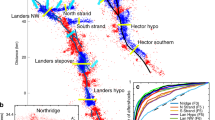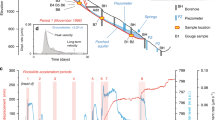Abstract
A SYSTEMATIC study of temporal changes in seismic b-values (defined as the log-linear slope of the earthquake frequency–magnitude distribution) has shown that large earthquakes are often preceded by an intermediate-term increase in b, followed by a decrease in the months to weeks before the earthquake1. The onset of the b-value increase can precede earthquake occurrence by as much as 7 years. A recently proposed fracture mechanics model of the earthquake source2 explains these temporal fluctuations in b in terms of the underlying physical processes of time-varying applied stress and crack growth. The model predicts two minima in b, separated by a short-lived maximum. Here we report the results of controlled laboratory deformation experiments, done in simulated upper-crustal conditions on both air-dried and water-saturated rock specimens. As found in previous experiments3–5, shear fracture in dry specimens is characterized by a decline in b during anelastic deformation to a single minimum reached just before failure. But in water-saturated specimens, when pore-fluid volume is kept constant by servo-control we also observe a second, intermediate-term b-value minimum, so reproducing the double b-value anomaly predicted by the model2.
This is a preview of subscription content, access via your institution
Access options
Subscribe to this journal
Receive 51 print issues and online access
$199.00 per year
only $3.90 per issue
Buy this article
- Purchase on Springer Link
- Instant access to full article PDF
Prices may be subject to local taxes which are calculated during checkout
Similar content being viewed by others
References
Smith, W. D. Nature 289, 136–139 (1981).
Main, I. G., Meredith, P. G. & Jones, C. Geophys. J. 96, 131–138 (1989).
Meredith, P. G., Main, I. G. & Jones, C. Tectonophysics 175, 249–268 (1990).
Sammonds, P. R., Ayling, M. R., Meredith, P. G., Murrell, S. A. F. & Jones, C. in Rock at Great Depth (eds Maury, V. & Fourmaintraux, D.) (Balkema, Rotterdam, 1989).
Lockner, D. A., Byerlee, J. D., Kiksenko, V., Ponomarev, A. & Sidorin, A. Nature 350, 39–42 (1991).
Mogi, K. Earthquake Prediction (Academic, London, 1985).
Atkinson, B. K. & Meredith, P. G. in Fracture Mechanics of Rock (ed. Atkinson, B. K.) (Academic, London, 1987).
Meredith, P. G. & Atkinson, B. K. Geophys. J.R. astr. Soc. 75, 1–21 (1983).
Main, I. Geophys. J. 92, 455–464 (1988).
von Seggern, D. Geophys. J.R. astr. Soc. 86, 815–838 (1980).
Utsu, T. Geophys. Mag. 30, 521–605 (1961).
Nur, A. M. & Walder, J. in The Role of Fluids in Crustal Processes (panel co-chair Bredehoeft, J. D. & Norton, D. L.) (National Academy Press, Washington DC, 1990).
Marquis, G. & Hyndman, R. D. Geophys. J. int. 110, 91–105 (1992).
Scholz, C. H., Sykes, L. R. & Aggarwal, Y. P. Science 181, 803–810 (1973).
Rice, J. R. Extended Abstr. int. Symp. Earthq. Source Phys. Earthq. Precursors 7–11 (Univ. of Tokyo, 1990).
Aki, K. Bull. Earthq. Res. Inst. Tokyo Univ. 43, 237–239 (1965).
Author information
Authors and Affiliations
Rights and permissions
About this article
Cite this article
Sammonds, P., Meredith, P. & Main, I. Role of pore fluids in the generation of seismic precursors to shear fracture. Nature 359, 228–230 (1992). https://doi.org/10.1038/359228a0
Received:
Accepted:
Issue Date:
DOI: https://doi.org/10.1038/359228a0
This article is cited by
-
Foreshock properties illuminate nucleation processes of slow and fast laboratory earthquakes
Nature Communications (2023)
-
Creep damage properties and nonlinear creep model of red sandstone treated at high temperature based on acoustic emission
Acta Geotechnica (2023)
-
Seismic events miss important kinematically governed grain scale mechanisms during shear failure of porous rock
Nature Communications (2022)
-
Seismic b-value reduction prior to the 28th April 2021, Mw 6.5 Sonitpur earthquake of Assam Valley
Journal of Earth System Science (2022)
-
Mechanical characteristics of thick-bedded limestone with different bedding angles subjected to acid corrosion
Bulletin of Engineering Geology and the Environment (2022)
Comments
By submitting a comment you agree to abide by our Terms and Community Guidelines. If you find something abusive or that does not comply with our terms or guidelines please flag it as inappropriate.



